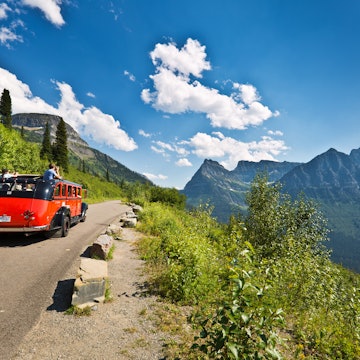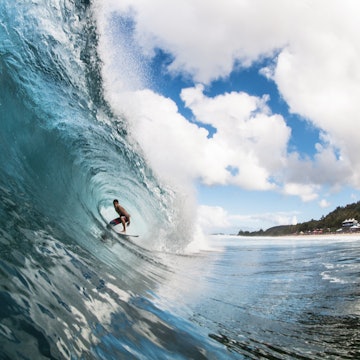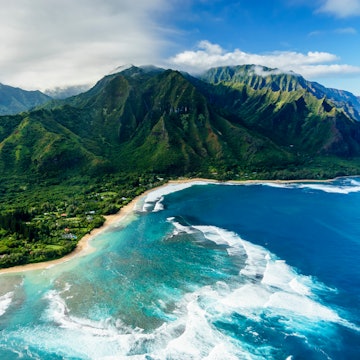

Sifting plastic waste on a beach cleanup is one way to give back to the land © Sunny Fitzgerald / Lonely Planet
If you’re planning a trip to Hawaii, you’re not alone. The remote archipelago in the Pacific receives flights and ships full of tourists every day – nearly 10 million per year. That number is expected to continue to grow, but as visitor numbers rise so do environmental costs.
The very elements that attract travelers to Hawaii – namely, the natural beauty and the local people and culture – are at risk of suffering under the weight of 10 million visitors. So if you’re headed to Hawaii, here's how to show the islands some aloha.

Choose wisely
One of the first things on a trip to-do list is booking a home away from home. It’s also one of the main ways travelers impact a destination for better or worse. Choose ‘better’ by narrowing your search to properties contributing to the community and respecting the environment, people, and culture.
Surfjack Hotel and Swim Club is an oasis of aloha in the sea of concrete and chain hotels of Honolulu. It’s also a property committed to environmental and cultural conservation. Surfjack was the first hotel in Waikiki to eliminate single-use plastic, but you won’t miss those wasteful disposable bottles: endless refills are available at hydration stations. You’ll also find free reef-safe sunscreen dispensers, plastic-free bikini and accessories pop-up shops, and 'talk story' sessions on cultural and environmental topics.
Mahina & Sun’s – a sea-and-farm-to-fork restaurant serving up Hawaiian flavors, locally grown produce and sustainably sourced seafood – is a highlight at Surfjack. The sea snapper is the obvious star but be warned: creative side dishes like pohole (fiddlehead) salad and the ‘ulu (breadfruit superfood) with chili pepper aioli are so addictive you might find yourself filling up on them and still begging for seconds.

Spend locally
Visitors consume resources and can create or exacerbate local challenges such as traffic and degradation of sites (to the point some destinations are asking tourists to stay away, and some sites are shutting down temporarily or even permanently). But tourism done right can create a positive economic impact. Support local businesses and ensure your money cycles into the local economy.
Grab a fresh bite at a family-run restaurant like South Shore Grill, near iconic Diamond Head crater (the macadamia nut pesto is a must). For a special night out and a taste of Hawaiian cuisine, sit down to dinner at Merriman’s (locations on Kaua’i, Maui, O’ahu, and the Big Island of Hawai'i. For some fun, ask your server to choose your entrée, then order an appetizer or share plate (the Farm to High Rise Kim Chee at the Honolulu location is killer) and a specialty cocktail. The No Ka ‘Oi (the best) cocktail topped with honey lilikoi (passion fruit) puree comes by its name honestly.
Farmers markets throughout the islands make it easy to buy fresh and local. Some, like Uncle Robert’s Wednesday Night Market on the Big Island, have live music so you can turn your shopping trip into an island-style night out. Don’t worry if you dance up a sweat; you can cool off with a chilly treat from Nicoco – organic vegan gelato made from locally-sourced coconut, coffee and cacao.
You can also go straight to the source and tour a working farm, like ONO Organic Farm on Maui or Kahumana Organic Farm & Café on O'ahu. Kahumana has a community-minded social mission and works with vulnerable populations, so every dollar you spend goes back into the community. Raise a glass of the chilled hibiscus-and-herb drink and cheers to that!

Tread lightly
Hawaii’s natural environment is fragile, and with 10 million visitors setting foot here each year, it’s at risk of being trampled. There are a number of ways to tread lightly and aloha 'aina (love and respect the land).
Hawaii played host to the first-ever World Reef Day and was the first U.S. state to ban sunscreens containing oxybenzone and oxtinoxate. The law will take effect in January 2021. But in the meantime, you can skip chemical sunscreens that pollute the ocean and harm marine life. Opt for reef-safe sunscreen like Raw Elements instead.
More tips: Carry your own reusable water bottle, bag, and utensils and say no to single-use plastics. Don’t harass or touch wildlife – it’s not only disruptive and potentially dangerous, in some cases (like with endangered Hawaiian Monk Seals and sea turtles) it’s illegal. Stay off the reef while swimming (touching or standing on reef destroys it and can injure you) and stick to marked trails while hiking.
Do venture away from the major tourist attractions to check out lesser-known activities like parts of Volcanoes National Park and forest bathing at Kahulu’u Gardens. Respect the sacred sites (yes, that means abiding by signs and fences even if other visitors disregard them. Don’t desecrate a sacred site for the ‘gram.)

Malama ‘aina
There is a concept in Hawaii called malama ‘aina, meaning to love and nurture the land. No doubt you will take more from Hawai’i than surf skills and a suntan – traveling brings new experiences, friends, inspiration, memories, and more. So why not give something meaningful back?
Keep an empty bag with you to collect trash you find on trails or beaches. Join a beach cleanup event with local organizations like 808 Cleanups on the Big Island or Sustainable Coastlines Hawaii on O'ahu. It’s a fantastic way to meet and mingle with a diverse mix of locals. 808 Cleanups even has an app and events calendar listing beach cleanups and activities such as wetland work days, shoreline restoration, and the planting of native limu, seaweed and algae.
Dig in deeper and get your hands dirty in the taro paddies of Ka Papa Lo‘i o Kānewai. You’ll learn about traditional farming methods, taro (a culturally significant Hawaiian crop), and Hawaiian history while working alongside locals. Or volunteer with Paepae o He’eia where you might be tasked with trash pickup, removing invasive mangrove or reconstructing a fishpond wall. The work can be challenging but the experience of teaming up with locals to malama ‘aina is unforgettable.
Get more travel inspiration, tips and exclusive offers sent straight to your inbox with our weekly newsletter. Check out adventure tours for every traveler from our trusted partners.
https://shop.lonelyplanet.com/products/best-of-hawaii-travel-guide-1
















